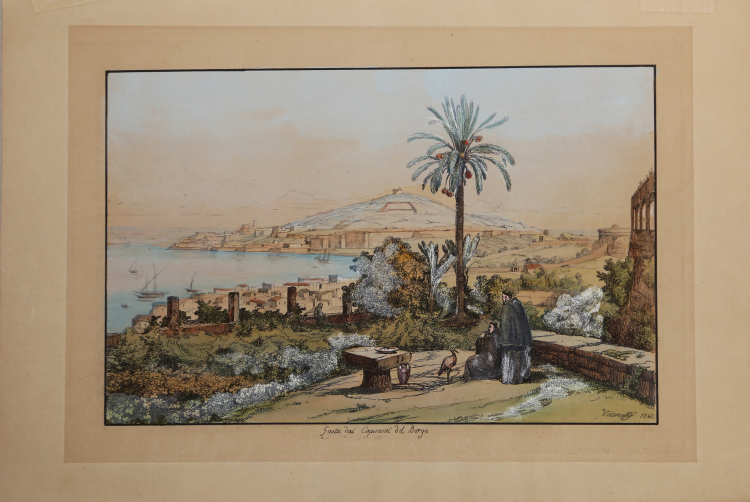


| Reference: | S9279 |
| Author | Achille VIANELLI |
| Year: | 1842 |
| Zone: | Gaeta |
| Printed: | Naples |
| Measures: | 337 x 235 mm |


| Reference: | S9279 |
| Author | Achille VIANELLI |
| Year: | 1842 |
| Zone: | Gaeta |
| Printed: | Naples |
| Measures: | 337 x 235 mm |
Veduta di Gaeta presa dal convento dei Cappuccini. Firmata e datata in lastra, in basso a destra, "Vianelli 1842".
Acquaforte su carta bruna, finemente colorata a mano, in ottimo stato di conservazione.
Rara.
Achille VIANELLI (Porto Maurizio di Imperia, 1803 - Benevento, 1894)
|
Italian painter and printmaker. In 1819 he moved to Naples where, together with Giacinto Gigante, he frequented the studios of Wolfgang Huber and Antonio Sminck Pitloo. He was taught to use the ‘camera lucida’, and his early work was tied to the panoramic tradition, using techniques similar to those of Raffaele Carelli (1818–1900). He soon abandoned oil painting and an obsession for formal perfection in favour of the watercolour and sepia works with which he made his name, gradually assuming a freer and almost impressionistic painterly style. Typical views include Bay of Naples (tempera; Florence, Uffizi) and the Madonna del Soccorso at Forio d’Ischia (watercolour, 1893; Benevento, Mus. Sannio). His interiors are typified by an evocative use of diffused light and shadow, as in the early Grotto of the Donn’Anna Palace (1825; Naples, Mus. N. S Martino) and also in Interior of Salerno Cathedral (1841; Naples, Accad. B.A.).
|
Achille VIANELLI (Porto Maurizio di Imperia, 1803 - Benevento, 1894)
|
Italian painter and printmaker. In 1819 he moved to Naples where, together with Giacinto Gigante, he frequented the studios of Wolfgang Huber and Antonio Sminck Pitloo. He was taught to use the ‘camera lucida’, and his early work was tied to the panoramic tradition, using techniques similar to those of Raffaele Carelli (1818–1900). He soon abandoned oil painting and an obsession for formal perfection in favour of the watercolour and sepia works with which he made his name, gradually assuming a freer and almost impressionistic painterly style. Typical views include Bay of Naples (tempera; Florence, Uffizi) and the Madonna del Soccorso at Forio d’Ischia (watercolour, 1893; Benevento, Mus. Sannio). His interiors are typified by an evocative use of diffused light and shadow, as in the early Grotto of the Donn’Anna Palace (1825; Naples, Mus. N. S Martino) and also in Interior of Salerno Cathedral (1841; Naples, Accad. B.A.).
|